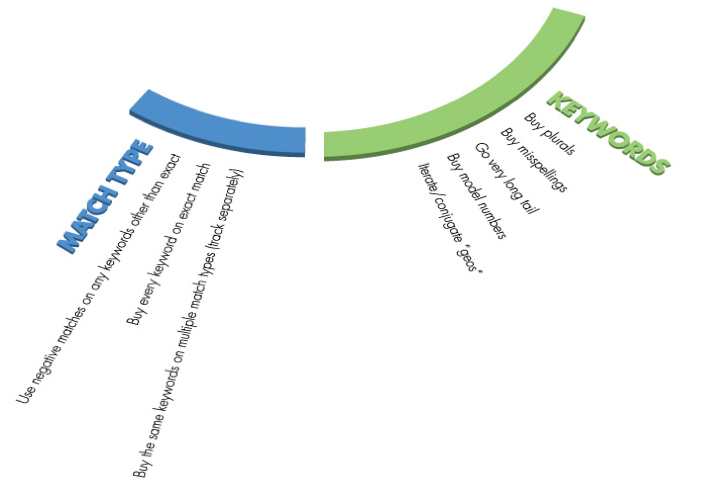Today we have a guest post from one of our PPC Hero allies! Ken Robbins is the President and Founder of Response Mine Interactive, an online marketing company dedicated to the idea that data and testing should drive marketing decisions and media optimization.
—————-
Search is like no other marketing channel. People are literally telling you what they want. In fact, all of the variations and iterations of ways people type in search terms are the way they think about what they want. Some want a new roof. Others want a new roofing estimate. This type of insight into the consumer’s mind is unprecedented. It is a perfect direct response testbed.
While the world of paid search quickly began to formulate a strategy around bidding tactics, we saw early on that marketers could get so much more performance and profits from search by expanding their thinking two ways: 1). Use all of the 30-plus search marketing tactics, instead of just bidding, and, 2) Better align your marketing with your process and strategy. To illustrate these best practices, we developed an infographic of ppc tactics that have led us to generate billions of dollars in revenue for our clients over the past decade. They are divided into four categories, all centered around measurement. Let’s start with creative.
Creative
Google, and all the search engines, want the best content to rise to the top. Best content is always that which is most relevant to the users’ queries. That means creative, varied by keyword, is the most powerful set of tactics you can employ. Fourteen, fully 40 percent, of the tactics listed here are creative and you’ll see they are all designed to make the ad more attractive to a searcher and more relevant to the search they typed.
The most obvious tactic in creative is to use keyword insertion. Keyword insertion pushes the actual query used by the consumer into the title of the tweet. When users scan the search results, they instantly cue onto the search ads that have their search term in the title. Next, if you are selling a product, using price points in the ad text or title improves the clicks and often increases the click-thru rate. When shoppers see a price like $79 in the ad, they are trained to know that this is an e-commerce site and they can buy the product there. This improves the click mix to include more shoppers, resulting in more conversions.
Finally on the matter of creative, just setting up your keywords into a large number of ad groups helps immensely. This allows you to tailor the creative by ad group much more specifically, which leads to higher CTRs and greater efficiency and volume.
Keywords and Match Types
Next, let’s focus on the next two groups of tactics — keywords and match types. Most people set up an account with all the words on broad match. This is a huge mistake. If you’re Delta Faucets and you put your brand name on broad match, you’ll get airline and table saw clicks. This lowers your CTR and your quality score. Never start off with broad match. When the strategy pendulum swings in the other direction with only exact match in the account, you end up cutting out too much volume.
There is a way to get both. Set up every keyword to run on all three match types. Put the exact match at your highest bid, your phrase match 20 percent below that and your broad match another 20 percent below that bid price. This set up ensures that the exact match creative and keywords will produce very efficient clicks. Then, the phrase match catches the closely searches and the broad match gets all the searches of terms you haven’t thought to add to the account yet.
Using this multi-match type technique means you will have to use more ad groups and write more creative but the payoff is worth it. You will get more volume and save a lot of money by going to an exact-match dominant strategy while backfilling your campaign with the looser match types. One word of caution: Even with low bids, be sure to build an ample supply of negative keywords for your broad match campaigns. It is so easy to have a high-volume broad match keyword drain your budget.
Bidding
This brings us to bidding. Bidding is the most powerful lever you can pull to increase or decrease volume quickly. That’s why it is so overused. Simple stated, you should raise the winners in your campaign and lower the losers. Don’t just pause a poor performer. Lower its bid to manage the costs then change the ad text to try to improve the clicks and ROI. The worst thing you can do it hyper-bid, which is changing the bids multiple times per day to improve your position. This is the worst because you cannot out bid Google and your competitors across a lot of keywords. The system is too dynamic and now, with personal results and Google Instant, the only thing you can really control is the creative to improve your CTR.
Measurement
The center of our chart is dedicated to measurement. Measure everything. Measure the clicks, sales AND calls by keyword. That’s the only way you can tell if the keyword is productive and profitable. Google and Bing are set up for any small business and newbie to run their own keyword campaign. However, setting up tracking is a science and is technical. It’s the one area where I would strongly consider getting an experienced person to help you.
If you’re an advanced marketer, start measuring all the value a keyword delivers. The most advanced marketers measure the assist value of a keyword, since often, searchers click on multiple keywords before converting. Also, measure not just the ROI, but the margin delivered by each keyword. If you are a retailer, you’ll have different gross margins on different categories of products. Optimizing your campaign solely on revenue wastes profits. Finally, the most advanced marketers measure the number of new customers a keyword delivers. If a keyword is bringing you a new customer then you should give it extra credit and raise its position over others. This puts you in the position of getting into customer acquisition, and not just transactions.
—————-








